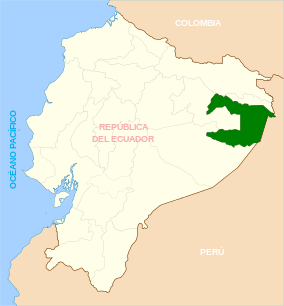Yasuni National Park
From Wikipedia, the free encyclopedia
| Yasuni National Park | |
|---|---|
IUCN category II (national park)
| |
| Yasuni National Park (dark green). | |
| Location | Napo and Pastaza province |
| Coordinates | 1°5′0″S 75°55′0″WCoordinates: 1°5′0″S 75°55′0″W |
| Area | 9823 km² |
| Established | July 26, 1979 |
Yasuni National Park (Spanish: Parque nacional Yasuní) is in Ecuador with an area of 9,820 km2 between the Napo andCuraray rivers in Napo and Pastaza provinces in Amazonian Ecuador. The national park lies within the Napo moist forestsecoregion and is primarily rain forest. The park is about 250 km from Quito and was designated a UNESCO Biosphere Reservein 1989. It is within the claimed ancestral territory of the Huaorani indigenous people. Yasuni is home to two uncontacted indigenous tribes, the Tagaeri and the Taromenane.[1]
Biodiversity[edit]
Yasuni National ground is arguably the most biologically diverse spot on Earth. The park is at the center of a small zone where amphibian, bird, mammal, and vascular plant diversity all reach their maximum levels within the Western Hemisphere. Moreover, the park breaks world records for local-scale (less than 100 km2) tree, amphibian, and bat species richness, and is one of the richest spots in the world for birds and mammals at local scales as well.[2]
The park holds a world record 150 amphibian species for places with comparable landscapes. It also is in the top for amphibian diversity compared to other sites sampled in the western Amazon.[2] The total of its amphibian species are more than the United States and Canada combined. Reptile species in the park is also very high with 121 documented species found. In spite of covering less than 0.15% of the Amazon Basin, Yasuni is home to approximately one-third of amphibian and reptile species. The park also harbors very high levels of fish diversity with 382 known species. This number is greater than the amount of fish species found in the whole Mississippi River Basin. Yasuni also is home to at least 596 bird species which comprises one-third of the total native bird species for the Amazon. The park is also very rich with many species of bats. On a regional scale, the Amazon Basin has an estimated 117 bat species but on a local scale, Yasuni is estimated to have comparable richness. In a single hectare, Yasuni has over 100,000 different species of insects which is roughly the amount of insect species that can be found in all of North America. The park also boasts one of the world’s richest levels of vascular plants. It is one of nine places in the world that has over 4,000 vascular plant species per 10,000 km2. The park contains many species of trees and shrubs and holds at least four world records for documented tree and liana richness as well as three world records for diversity in woody plant species. The park also hosts a list endemic species such as 43 different species of vertebrates and 220–720 different plant species.[2] A species of bat, Lophostoma yasuni, is endemic to the park.



